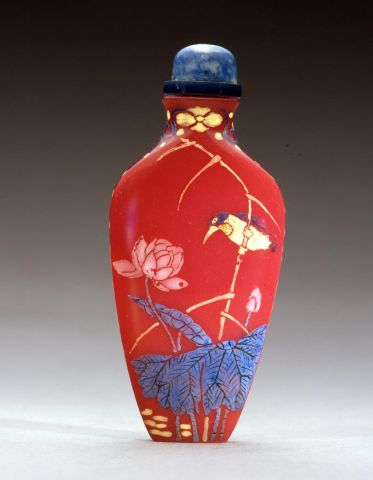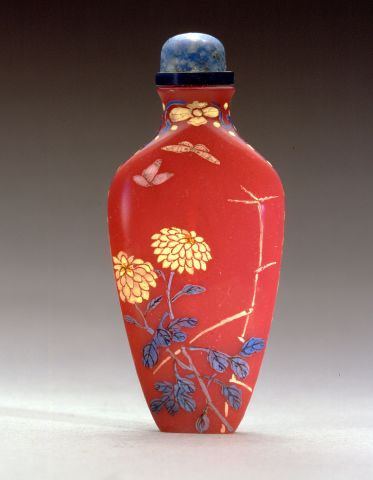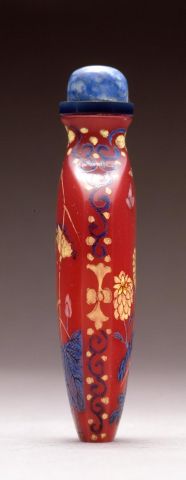


Bottle ID: 00204
YANGZHOU, REDDISH PURPLE, KINGFISHER & GARDEN LANDSCAPE
Date: 1770-1820
Height: 64 mm
Glass, of opaque dark reddish-purple color, of elongated tapering ovoid form with flattened sides, the shoulders ascending to a neck with everted mouth, decorated in famille rose enamels, with on one side a bird perched on a swaying grass above a blooming lotus flower and leaves rising from the waters below; the reverse with two butterflies flying above chrysanthemums and grasses; the neck with a scrolling flower-head band; the sides with a similar vertical scrolling band.
Attributed to Yangzhou.
Similar Examples:
Crane Collection nos. 240 and 430.
Stevens, Bob C. The Collector's Book of Snuff Bottles, 1976, p. 268, no. 963.
Kleiner, Robert. Treasures from the Sanctum of Enlightened Respect, 1999,
p. 23, no. 17.
Christie's, New York, October 18, 1993, lot 239, The Reif Collection.
Provenance:
Clare Lawrence Ltd.
Christie's, New York, November 2, 1993, lot 450
Exhibited:
Annual Convention ICSBS Toronto, October 2007
Published:
JICSBS, Winter 2008, p. 13, figs. 17a and 17b
JICSBS, Spring 2006, p. 31, fig. 41
The Crane Collection has amassed a fascinating group of enamel on glass bottles, allowing for comparisons which lead both to a greater appreciation and hopefully a deeper level of knowledge.
One of the groups which can be separated from the "Imperial" group and possibly attributed to Yangzhou, a known center of enameling, includes this bottle and two others, Crane Collection no. 240 and no. 430. Unlike the standard milk-white glass bottles with their flattened rounded forms, these bottles are often of varying monotone colors of glass, of which turquoise and caramel brown appear to be the most prevalent color. The reddish-purple tone of this bottle is very rare and provides a dramatic ground for the opaque colored enamels that decorate it. Interestingly, while most of this group are natural designs of foliage and insects, this example is decorated on one side with a kingfisher above lotus. The blue enameled lotus in the center of one side of the bottle also bears some allegiance to the Wu Yuchuan group, although the connection is not entirely clear, particularly if the Wu Yuchuan group is attributed to the Palace Workshops (as Hugh Moss does). Both Crane no. 204 and no. 430 also have flattened straightened sides, although this example is of an elongated form. The shape serves the bottle well in separating the two main sides of the bottle even though the naturalistic scene on each side is very similar.
< Back to full list
 English
English 中文
中文